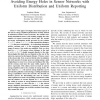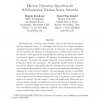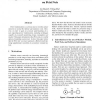264 search results - page 36 / 53 » Towards Multiservice Sensor Networks |
INFOCOM
2006
IEEE
14 years 1 months ago
2006
IEEE
— This paper investigates theoretical aspects of the uneven energy depletion phenomenon recently noticed in sink-based wireless sensor networks. We consider uniformly distributed...
ADHOCNOW
2010
Springer
13 years 9 months ago
2010
Springer
Random walks in wireless sensor networks can serve as fully local, very simple strategies for sink motion that reduce energy dissipation a lot but increase the latency of data coll...
ADHOC
2006
13 years 7 months ago
2006
Self-organization of wireless sensor networks, which involves network decomposition into connected clusters, is a challenging task because of the limited bandwidth and energy reso...
ICPPW
2008
IEEE
14 years 2 months ago
2008
IEEE
Power minimization is a serious issue in wireless sensor networks to extend the lifetime and minimize costs. However, in order to gain an accurate understanding of issues regardin...
COMCOM
2006
13 years 7 months ago
2006
This paper describes an INtrusion-tolerant routing protocol for wireless SEnsor NetworkS (INSENS). INSENS securely and efficiently constructs tree-structured routing for wireless ...



